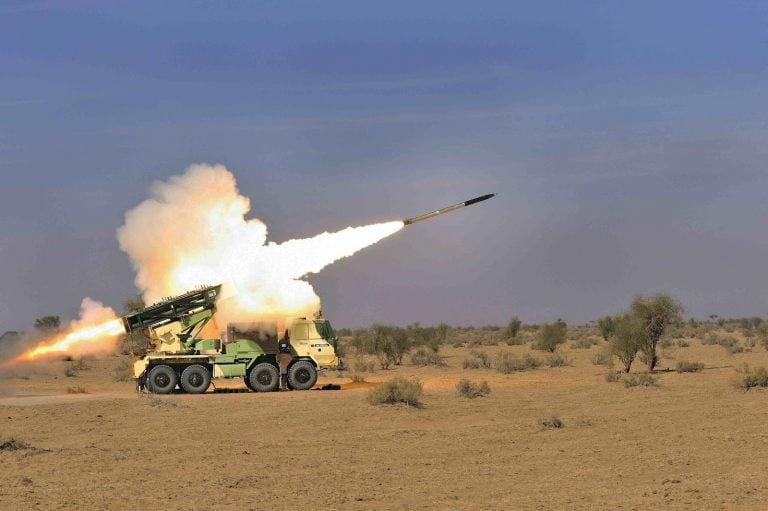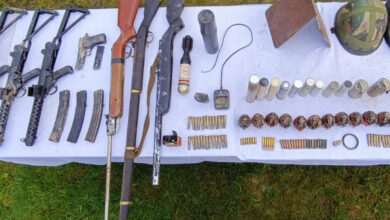India Will Purchase Guided Pinaka Rockets, Carbine Rifles, And Swarms Of Drones

- The Army also has five BM-21 Grad regiments and three BM-30 Smerch regiments that have been upgraded and are still operational.
- The Indian Coast Guard has also been authorised to proceed with the acquisition of 14 Fast Patrol Vessels.
Acceptance of Necessity (AoN) was granted by India’s Ministry of Defence for armed forces acquisition proposals totaling 28,732 crore ($3.56 billion). This was decided at a meeting of the Defence Acquisition Council (DAC) on July 26.
All programmes are classified as Buy (Indian IDDM) or Buy (Indian), with a focus on domestic firms. AoNs are granted for items deemed operationally critical.
Two of the proposals were for the Pinaka rocket artillery system, which will receive Guided Extended Range Rocket Ammunition and Area Denial Munition warheads. The DRDO-developed Guided Pinaka rocket has a range of 75 kilometres.
Eight such rockets can be carried by a single Pinaka launcher using GPS + INS guidance, compared to 12 unguided Mk-1, Mk-1 Enhanced, or Mk-II type rockets. The acquisition of these rockets will nearly double the Pinaka system’s current range and provide it with precision strike capability.
Area Denial Munition warheads are made up of dual-purpose submunitions that are effective against armoured vehicles and personnel. The Indian Army has four Pinaka regiments, with six more ordered in 2020 and scheduled to be inducted by 2024.
By the end of this decade, it is expected to have 22 Pinaka regiments. Each regiment is equipped with 19 Pinaka launchers and associated equipment. More information on the Pinaka rocket family can be found here. The Army also has five BM-21 Grad regiments and three BM-30 Smerch regiments that have been upgraded and are still operational.
An AoN has been granted for the procurement of new bullet proof jackets and 5.56x45mm carbines for the infantry elements of the Army, Navy, and Air Force. This is expected to result in a contract after the services’ long-delayed effort to urgently procure over 90,000 CAR816 carbines from UAE firm Caracal stalled.
Over 400,000 new carbines are required in total. Following a new bidding process, two Indian firms are expected to be selected to manufacture their carbines in India.
The Indian armed forces are continuing to invest in their small UAS capabilities. The DAC also granted AoN for the Army to purchase Autonomous Surveillance and Armed Drone Swarms (A-SADS), which has spearheaded the adoption of such drones. Two types of swarms are required: one for use in the desert and plains, and the other for use in high altitude regions.
A-SADS have a range of 50km and an endurance of 3 hours and can be launched via VTOL or tube. The desert and plains variant must carry a 5kg explosive payload, while the high altitude variant must carry at least a 2kg explosive payload. Meanwhile, a command version of the BMP-II IFV will be purchased to improve the mechanised units’ decision-making capabilities.
The efforts of India to develop guided Pinaka rockets and explosive capable swarm drones predate Russia’s invasion of Ukraine in February 2022. The notable success of similar systems in the war, on the other hand, would provide confidence to Indian decision makers and potentially speed up acquisition.
HIMARS rocket systems supplied by the United States have allowed Ukraine to precisely target multiple Russian ammunition depots, while Ukrainian forces continue to outfit commercial drones with explosive payloads. Such systems have also been used successfully by Russian forces.
The war has also highlighted the need for mechanised units to adapt in order to face new threats. A swarm’s ability to carry and deliver explosive payloads would pose a new challenge to India’s adversaries. Swarm drones for cargo delivery have already been demonstrated by India and China near the Line of Actual Control, where tensions remain high.
The DAC also approved the Indian Navy’s proposal to purchase an upgraded 1.25MW class marine gas turbine generator for use in power generation on the Kolkata class of ships. This will significantly boost domestic manufacturing of gas turbine generators. The Indian Coast Guard has also been authorised to proceed with the acquisition of 14 Fast Patrol Vessels.







Facebook Comments